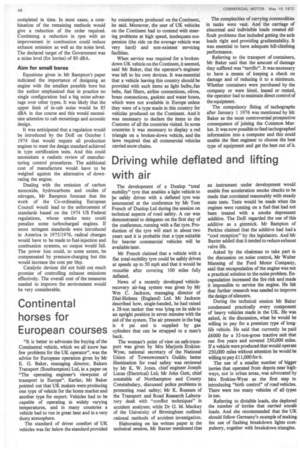Driving while deflated and lifting with air
Page 50

If you've noticed an error in this article please click here to report it so we can fix it.
The development of a Dunlop "total mobility" tyre that enables a light vehicle to be safely driven with a deflated tyre was announced at the conference by Mr Tom French of Dunlop Ltd during the session on technical aspects of road safety. A car was demonstrated to delegates on the first day of the conference, running with a flat tyre. Production of the tyre will start in about two years and it is probable that a type suitable for heavier commercial vehicles will be available later.
Mr French claimed that a vehicle with a flat total-mobility tyre could be safely driven at speeds up to 50 mph and that it would be reusable after covering 100 miles fully deflated.
News of a recently developed vehiclerecovery air-bag system was given by Mr Wm C. Jackson, managing director of Dial-Holmes (England) Ltd. Mr Jackson described how, single-handed, he had raised a 28-ton tanker that was lying on its side to an upright position in seven minutes with the aid of the system. The air pressure in the bag is 6 psi and is supplied by gas cylinders that can be strapped to a man's back.
The woman's point of view on safe transport was given by Mrs Marjorie ErskineWyse, national secretary of the National Union of Townswomen's Guilds; better illumination for road safety was reviewed by Mr K. W. Jones, chief engineer Joseph Lucas (Electrical) Ltd; Mr John Gott, chief constable of Northampton and County Constabulary, discussed police problems in promoting road safety; Mr K. Russam of the Transport and Road Research Laboratory dealt with "conflict techniques" in accident analyses; while Dr G. M. Mackay of the University of Birmingham outlined rational methods of accident investigation.
Elaborating on his written paper in the technical session, Mr Baxter mentioned that
an instrument under development would enable free acceleration smoke checks to be made that correlated reasonably with steady state tests. Tests would be made when the engines were running on a fuel that had not been treated with a smoke depressant additive. The DoE regarded the use of this additive as a gimmick. Mr Bampton of Perkins claimed that the additive had had a "cool reception" by the legislators. And Mr Baxter added that it tended to reduce exhaust valve life.
Asked by the chairman to take part in the discussion on noise control, Mr Walter Manning of the Ford Motor Company, said that encapsulation of the engine was not a practical solution to the noise problem. Encapsulation increased the fire risk and made it impossible to service the engine. He felt that further research was needed to improve the design of silencers.
During the technical session Mr Baker condemned practically every component of heavy vehicles made in the UK. He was asked, in the discussion, what he would be willing to pay for a premium type of longlife vehicle. He said that currently he paid £6000 for a 32-ton-gross tractive unit that ran five years and covered 250,000 miles. If a vehicle were produced that would operate 250,000 miles without attention he would be willing to pay £11,000 for it.
The use of a smaller number of bigger lorries that operated from depots near highways, not in urban areas, was advocated by Mrs Erskine-Wyse as the first step to introducing "birth control" of road vehicles. There were too many vehicles of all types in use.
Referring to divisible loads, she deplored the number of lorries that carried unsafe loads. And she recommended that the UK should follow Germany's example of making the use of flashing breakdown lights compulsory, together with breakdown triangles.




























































































































